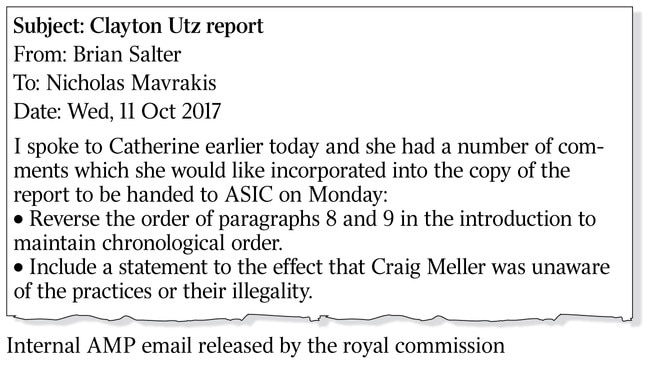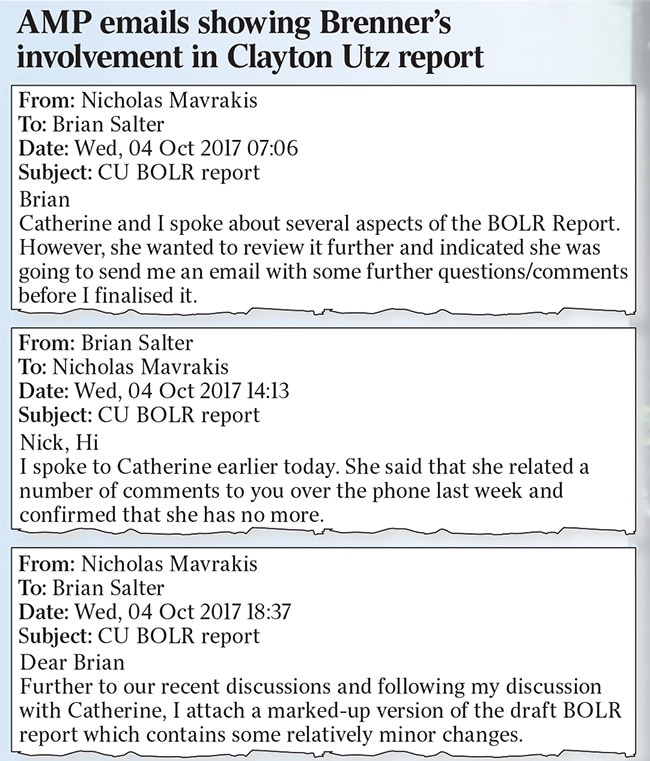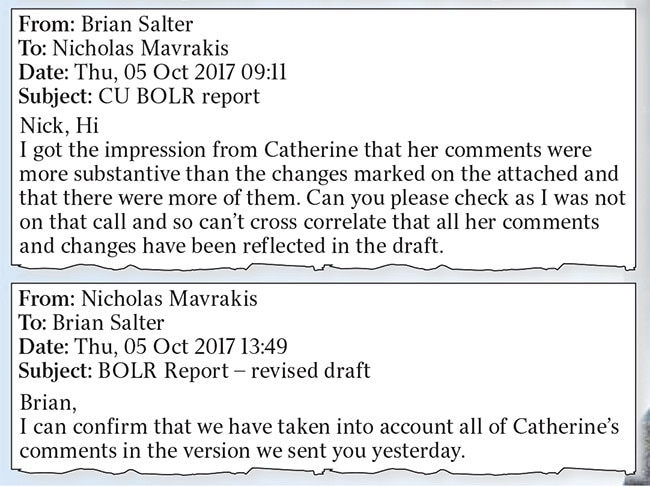Revealed: email trail that caused a financial giant to unravel
The emails that caused AMP to unravel, released by the banks inquiry, provide an astonishing glimpse inside the company.

It was on October 15 last year, the day before a critical AMP board meeting to discuss an internal scandal, that chairman Catherine Brenner asked the company’s lawyers for a draft script she could follow in a meeting the next day with the corporate regulator.
In an email to AMP’s general counsel Brian Salter, she asked when she could see a list of talking points she could use with ASIC. She wanted to take it to the AMP board for a discussion in the morning before meeting ASIC in the afternoon.
She asked too whether Clayton Utz — the external law firm commissioned by AMP’s board to conduct an independent investigation into the scandal — had included changes she requested in the report to make it clear CEO Craig Meller had had no knowledge of the “fees-for-no-service” saga.
“Dear Brian,” Brenner wrote in the October 15 email at 11.09am, “Just following up on the draft script/talking points for tomorrow afternoon’s meeting with ASIC as we need to discuss those at tomorrow morning’s board meeting and I would like to see them first. Has CU now included in their report that we will give to ASIC their findings on Craig? Kind regards, Catherine.”
Salter forwarded the chairman’s query to Nick Mavrakis, the Clayton Utz partner in charge of the report:
“Nick, Hi. Please see Catherine’s request below. Kind regards Brian.”
Brenner’s emails came to light on Friday afternoon when the royal commission into banking misconduct pressed the button to release a huge trove of extraordinary documents.
Almost Shakespearean in its timing, the commission’s data dump came about six hours after a last-ditch effort by AMP to rebut allegations and evidence from the Hayne commission with a submission released around 10am.
Counsel assisting the Hayne financial services royal commission, Rowena Orr, QC, last month said the commission was open to find AMP committed crimes by deliberately misleading ASIC about the “independence” of the Clayton Utz report.
Ms Orr alleged AMP chairman Catherine Brenner, chief executive Craig Meller and “particularly” chief counsel Brian Salter “either marked up or suggested amendments” to the report.
Brenner, who quit a week ago in the teeth of the scandal, featured in many of the new commission documents. This trove provided a rare and astonishing glimpse inside the company.
They also provide a glimpse of general counsel Brian Salter, who was fired by AMP on the same day Brenner resigned, as working closely with the chair, keeping her updated with progress, responding to her questions and requests for changes.
In Brenner’s June 5, 2017, letter to Clayton Utz commissioning the report, the law firm was instructed to undertake an external and independent investigation. It would interact on a day-to-day basis with the head of advice, Jack Regan, and Salter. Any issues relating to top executives or directors should be referred to Brenner herself.
Yesterday, Mike Wilkins, the interim executive chairman of AMP, defended both the board and former chair Brenner.
“The Clayton Utz report was commissioned by the board, for the board and certainly we did not have any hand in approving it, it was just going to be received,” Wilkins said.
“We did on Friday put our submission in, and in that we did say we don’t believe there’s any evidence to suggest that the board, including the former chairman, acted inappropriately in relation to the preparation of that report.”

Emails released by the commission reveal interactions between Brenner, Salter and Mavrakis.
On Sunday, September 24, last year, Mavrakis anticipated sending a revised draft of the Clayton Utz report to Brenner the next day, but he was concerned about formatting changes in the document. “That will be sorted on the version sent to the chair tomorrow,” he wrote to Salter.
Salter wrote back to Mavrakis, forwarding an email he had sent a week earlier to CEO Craig Meller and advice head Jack Regan. Salter wanted Mavrakis to keep Brenner updated.
“Nick, hi. As foreshadowed in my other email, here is my note last week to Craig and Jack. Can you please incorporate (and update) a version of paragraphs 2, 3 & 4 into your email to Catherine forwarding the draft report to her. I have already sent Catherine a copy of my email last week to Craig and Jack summarising the liability position, so there is no need for you to deal with this with her …”
On September 25, at 2am, Mavrakis forwarded the draft report directly to Brenner with a significant road map to the data contained. In closing, he set the time and date for a phone call with the chair to discuss the draft. “I look forward to speaking with you at 4.30pm on Monday Chicago time/7.30am Tuesday Sydney time. Regards, Nick.”
“Thanks Nick. I look forward to our call,” Brenner replied, pressing ‘send’ at 10.08pm.
Nine days later, on October 4 at 6.49am, Salter was at his computer early. He emailed Mavrakis asking about his phone call with Brenner. “Nick hi. Can you let me know the outcome of your call with Catherine. Also, are we now to assume your report is in final form? If so, can you please issue it. Kind regards, Brian.”
At 7.06am, Mavrakis replied. “Brian,” he wrote, “Catherine and I spoke about several aspects of the (BOLR) report. However she wanted to review it further and indicated she was going to send me an email with some further questions/comments before I finalised it. I have not received those comments. So at this stage it remains in draft.”
At 2.15 that afternoon, Salter wrote back to Mavrakis. “Nick, Hi. I spoke to Catherine earlier today. She said that she relayed a number of comments to you over the phone last week and confirmed that she has no more. Can you please let us have the next draft with the amendments marked up (today?). Kind regards, Brian.”
At 6.37pm that night, Mavrakis wrote to Salter. “Brian, Further to our recent discussions and following my discussion with Catherine, I attach a marked-up version of the draft … Please let me know if you have any final comments so that we can finalise the report.”
The next day, October 5, Salter wrote back to Mavrakis. “Nick, Hi. I got the impression from Catherine that her comments were more substantive than the changes marked on the attached and that there were more of them. Can you please check as I was not on that call and so can’t cross-correlate that all her comments and changes have been reflected in the draft …”
Mavrakis responded a few hours later to confirm that Brenner’s requests were included. “Brian, I can confirm that we have taken into account all of Catherine’s comments in the version we sent you yesterday … regards.”
The final report (or so everyone thought at the time) was forwarded to Brenner on October 6.
Four days later, Brenner had more changes to add. Salter wrote to Mavrakis on October 11 at 2.50pm. “I spoke to Catherine earlier today and she had a number of comments which she would like incorporated into the copy of the report to be handed to ASIC on Monday …. Include a statement to the effect that Craig Meller was unaware of the practices or their illegality. Specify in paragraph 134 who in senior management Susan Wolfe raised the ring fencing issue with. Also why is the ring fencing issue in inverted commas? She is concerned about the imprecision of the term “senior management”. It’s not clear who this covers …” Brenner’s concerns, related in detail by Salter to Mavrakis, went to the question of identifying specific people.
Four days later on October 15, Brenner pressed again, asking if changes had been included in the report regarding Craig Meller. Salter forwarded her email to Mavrakis. “Nick, Hi. Please see Catherine’s request below.”


It was now less than 24 hours until the AMP board meeting to consider the report and still the findings on the CEO were a matter for debate about whether to include or not.
Mavrakis wrote to Salter at 5.21pm, explaining that Meller had told Clayton Utz he had been unaware of the issues under investigation. Mavrakis said he would add this to the additional report pages going to the board the next day. The previously final version of the report had been sent to directors a week before on October 10.
Half an hour later, at 6pm on October 15, Salter emailed all directors to advise them of the latest changes. “Dear AMP Limited Directors,” he wrote. “Clayton Utz have made some amendments clarifying elements of their report following feedback through the chairman.” Salter attached the amendments to his email.
Six months later, before morning tea time on April 30, Salter was fired by AMP after involving himself on a day-by-day basis with the report, notwithstanding the express instructions from the board, through Brenner, that he was required to do so.
Brenner quit the night before Salter was thrown under the bus. AMP said the board had been unaware of the extent of his involvement in the report. Regarding Brenner, the company said she was “unaware” of changes made to the Clayton Utz report. Brenner herself said she was accountable for governance at the AMP.
For his part, Salter said he had done nothing wrong.






To join the conversation, please log in. Don't have an account? Register
Join the conversation, you are commenting as Logout